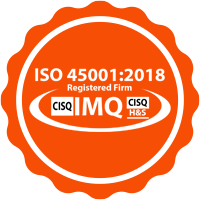Close

ISO 45001
Thousands of people die every day due to accidents and occupational diseases, while these deaths are preventable and organizations must prevent such accidents. ISO 45001 was created to prevent diseases and occupational accidents. ISO 45001 is an international standard provided by the International Organization for Standardization (ISO) and provides the requirements for occupational safety and health management system. An organization is responsible for the occupational health and safety of workers and other persons affected by the activities of the organization. This responsibility includes promoting and protecting their physical and mental health. Adopt an occupational safety and health management system to enable the organization to provide safe and healthy work environments, prevent work-related injuries and diseases, and continuously improve occupational safety and health performance.
History of ISO 45001
The basis of ISO 45001 is OHSAS 18001. To establish such a standard, a committee was first set up in 1998 under the auspices of the British Standards Institution (BSI). The first version of the standard was first introduced in 1999 to reduce risk in organizations and keep the occupational safety of employees as high as possible. Finally, the last version of this standard was presented in 2007 and many companies started to implement this standard. Since this standard was not provided by the International Organization for Standardization, there was a need for an international standard to promote occupational safety and health in the workplace.
ISO 45001 was first proposed in October 2013 at the ISO. In the same year, the ISO/PC 283 Committee was established, which was directly responsible for the standardization process. Finally, on March 12, 2018, while the first draft of the standard was not accepted from 2015 to 2017, the second draft of the standard was accepted with amendments.
Although both ISO 45001 and OHSA 18001 are standards for occupational safety and health management, there is a significant difference between ISO 45001 and OHSAS 18001. While OHSAS 18001 focused more on the internal affairs of the organization, ISO 45001 focused more on the interaction between an organization and its business environment. Other differences include the following:
ISO 45001 is process-based while OHSAS 18001 is method-based;
ISO 45001 is dynamic in all clauses while OHSAS 18001 is not;
ISO 45001 considers risk and safety and health opportunities while OHSAS 18001 deals with risk;
ISO 45001 takes into account the views of stakeholders, but OHSAS 18001 does not;
Also, one of the advantages of this standard is the possibility of easier integration with the quality management system and ISO 14001, because this document has been created under the requirements of ISO for the standards of the management system. This standard includes high-level structures, objective provisions, and common terms with specific meanings that are intended to be used by users to implement ISO standards.
Benefits of ISO 45001 standard?
Among the advantages of this standard are the following:
• Identify risk and improve risk assessment
• Reduce occupational accidents and diseases
• Reduce the cost of illness and occupational accidents
• Increase workers' participation and leadership
• Respond to the needs and expectations of customers and stakeholders
• Increasing acceptance by regulators and stakeholders
• Ensure compliance with national and international law
• Improve management oversight (including monitoring and measuring key performance indicators in health and safety)
• Continuous improvement in safety and health
How to get ISO 45001 certificate?
In order to receive the certificate of occupational safety and health management system, the organization must be able to implement the requirements of this management system. In this regard, the following items are recommended for better and more effective implementation of occupational safety and health management system in the organization.
1- Commitment and dedication of the organization managers
2- Selecting a qualified consultant (to select a qualified consultant ISO 10019 can be a good guide for organizations).
3- Creating a team to implement occupational safety and health management system
4- Providing the necessary training and knowledge in the organization
5- Compilation of occupational health and safety management system documents
6- Implementation of management system in the organization
7- Carrying out an internal audit in the organization
8- Requesting an external audit from certification companies
In general, to obtain a certificate of occupational safety and health management system of the organization, it must be shown that the following items have been implemented in the organization:
• Comply with the requirements provided by this standard
• Meet the legal requirements and needs of customers and the expectations of stakeholders
• Document the evidence of the safety and health management system
By receiving this certificate, organizations can show their customers and stakeholders that their needs and expectations have been met. Of course, in some organizations or industries obtaining this certificate may be a legal requirement or obligation.
Ark Safety Industry in order to achieve its goals and meet the expectations of customers and stakeholders implemented a occupational safety and health management system (ISO 45001) in 2020. In August and September 2020, the first and second rounds respectively were audited by the auditors of Marzban Quality Group. Ark Safety Industry succeeded in obtaining the occupational safety and health management system certification from IMQ Italy.
Just Take the First Step...

 Military Shoe
Military Shoe
 Safety Shoe
Safety Shoe
 Work Wear
Work Wear
 Office Shoe
Office Shoe
 Hiking Shoe
Hiking Shoe


